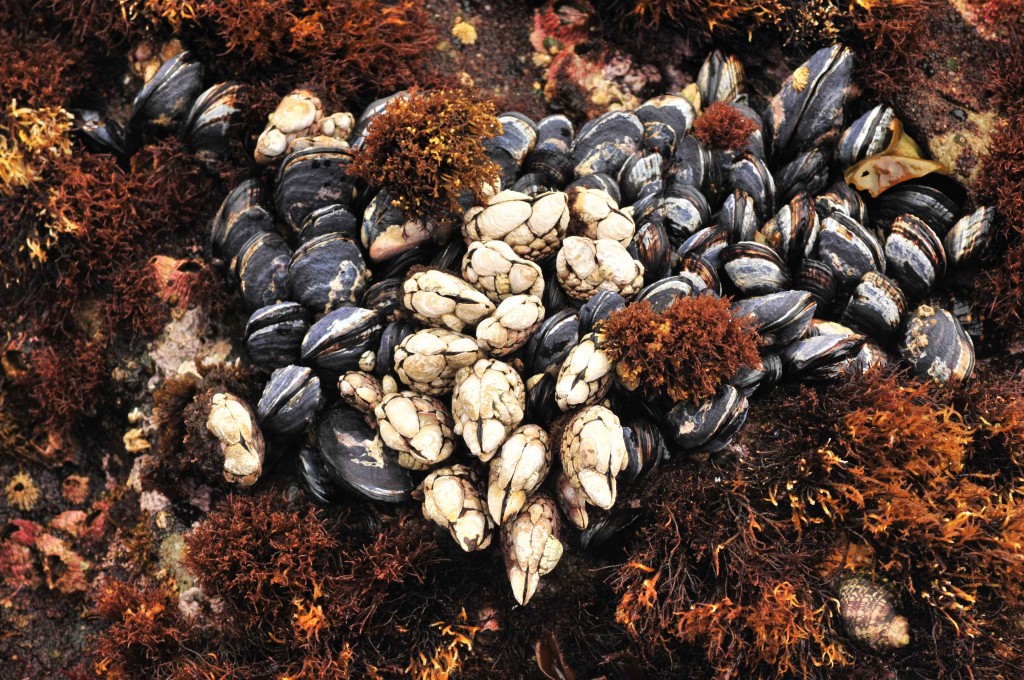9 December 2011
Surviving an acidic tide
Posted by kramsayer

Sensors from California to Oregon track acidity changes that marine animals like urchins and mussels live with, to get a handle on how they will respond to ocean acidification (Credit: Tom Kennedy)
Francisco Chavez has been studying a single bay in northern California for over half his scientific career. But his work isn’t isolated; his measurements are helping tell the story of Pacific Ocean acidification.
Two decades of data from the Monterey Bay Aquarium Research Institute (MBARI) show how ocean nutrients, plant activity and sea surface temperature have gone up and down over time. They also show how carbon dioxide and acidification have increased, while oxygen has decreased deep in the water.
Those observations inspired Chavez and his colleagues to ask how sea life will respond to ocean acidification. Chavez presented preliminary results Wednesday afternoon in a poster session on ocean acidification at the American Geophysical Union’s Fall Meeting.
Sensors that measure ocean temperatures and pH were developed by MBARI and have been deployed at eight sites from Santa Barbara, Calif., to Oregon. The sites have one sensor anchored off-shore and another tube-shaped sensor taking measurements in the intertidal zone — out of water at low tide and under water at high tide.
The sensors monitor the water’s acidity, which cycles naturally but is increasing globally due to the absorption of atmospheric carbon dioxide into the ocean.
Chavez showed that Monterey Bay, like other swaths of the northeast Pacific Ocean, has become colder at the surface since the 1997-98 El Niño, one of the natural climate cycles that affect ocean temperatures. Ocean upwelling increased over the same time, bringing cold, acidic and nutrient-rich waters to the surface.
The measurements Chavez and his colleagues are taking will help scientists understand how marine invertebrates like mussels and seas urchins respond to changes in ocean acidity. Urchins and mussels have calcium carbonate shells that scientists worry will dissolve in an increasingly acidic ocean.
Chavez said that the research team is already seeing surprising results from their pH sensors.
While ocean pH measurements decrease gradually over a decade, at an intertidal site the researchers measured daily fluctuations many times greater than the long-term trend.
Those measurements show that intertidal creatures live with swings in ocean acidity that happen over short periods, Chavez said. No one knows, however, how marine organisms will deal with increasingly more acidic waters on top of the natural changes they are accustomed to.
“Are they going to be able to adapt?” Chavez asked. “Have they already adapted?”
– Sarah Jane Keller is a science communication graduate student at UC Santa Cruz










 GeoSpace is a blog on Earth and space science, managed by AGU’s Public Information staff. The blog features posts by AGU writers and guest contributors on all sorts of relevant science topics, but with a focus on new research and geo and space sciences-related stories that are currently in the news.
GeoSpace is a blog on Earth and space science, managed by AGU’s Public Information staff. The blog features posts by AGU writers and guest contributors on all sorts of relevant science topics, but with a focus on new research and geo and space sciences-related stories that are currently in the news.